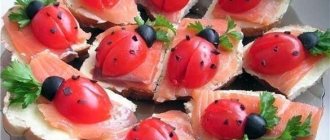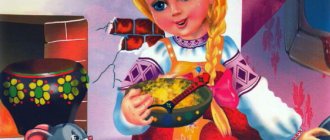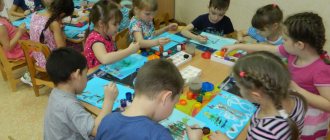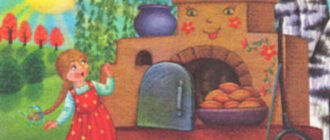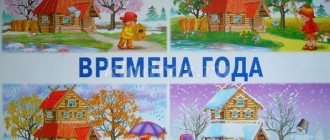Ladybugs sandwich recipe
Ingredients: sliced loaf, butter, tomatoes, pitted olives, parsley leaves. Preparation: cut the loaf into thin slices, each of which is also cut in half. Brush all halves of the slices with butter and garnish with parsley leaves. Cut the tomatoes in half, cut each half crosswise in the form of wings. Make a ladybug head from half an olive. Make black spots for the wings from small pieces of olives, insert them into the wings, piercing small holes with a knife. Place the tomatoes on the loaf slices, and also decorate the sides with parsley. Very tasty and unusual!
If you found the information on the site useful, please share it on social networks:
Cookie Policy
about the author
A teacher, philologist, she was engaged in local history work at a school in the village of Magnitka, Chelyabinsk region.
Author of several projects on the history of the Urals. One of the projects is dedicated to the post-war history of the village where the German prisoner of war camp was located.
Lyubov Alyamkina’s stories were published in various magazines and newspapers: “Ural Pathfinder” (Ekaterinburg), “Arguments of the Week” (Chelyabinsk), “District Life” (Kusa), “Russian Germany” (Berlin), “Russian Germans” (Moscow) and etc.
LADYBUG
There was one bug living in the forest. It was so small that it could fit on your little finger. There were tiny black peas on its bright orange wings.
This bug's name was Ladybug.
One day, Ladybug was basking in the sun on a white chamomile petal. How many of them grew here in the clearing!
Ladybug lived very happily and thought that there was nothing better in the world than her forest.
And suddenly children ran into the clearing with noise and cheerful screams.
“Oh, look, Ladybug,” one boy shouted joyfully and carefully took her off the flower, “how pretty she is!”
Ladybug fearlessly walked along the boy's hand, and the children jumped around and sang:
Ladybug,
Fly to the sky
Your kids are there
They eat sweets.
Ladybug thought that this was true and, spreading her wings, flew up. But she didn’t find any of her children there, and no one treated her to candy in heaven. Sad, she sat down on a bush and cried. She so wanted to see her children and eat at least one piece of candy.
At this time, two swallows were sitting on a branch nearby. They hid among the leaves of a tree from a suddenly blowing cold wind.
“Autumn is coming,” said one of them, “and we will fly to warm countries again.”
Ladybug thought:
- What if we fly away with them?
“Take me with you!” she asked the birds.
“We don’t feel sorry, we don’t feel sorry,” they sang.
And when autumn came, the birds rose high, high into the sky, flying to warm lands, not forgetting about the Ladybug, who was so warm and cozy among the feathers of one of the birds. Forests, steppes, mountains, and rivers rushed by below. Ladybug was so tired from the journey that she fell asleep unnoticed.
“Get up, we’ve already arrived,” the swallow woke her up.
It was so wonderful all around! Palm trees, strange plants, bright flowers - Ladybug has never seen such divine beauty. Birds in bright plumage walked among the fragrant bushes.
“I’ll stay here forever!” thought Ladybug.
She sat on an olive branch and thanked the swallow.
“Goodbye!” said the bird. “When we return home, we will fly to you.”
Ladybug didn't answer.
She didn’t even notice how close the Peacock came in his festive attire. He squinted one eye and began to peck at the berries.
Suddenly, Ladybug felt a terrible blow, from which she fell to the ground and miraculously remained alive. It was the Peacock who hit her with his beak. Everything happened so quickly that poor Ladybug barely recovered from her fear and spent the whole day sitting on the ground under a fallen leaf.
Now she had to be careful and hide at times.
Nobody knew her in this country. The grasshoppers did not greet her in the morning, the caterpillar did not crawl past her, having managed to tell the forest news, butterflies with fabulously beautiful wings simply did not want to notice her, flying past indifferently.
And most importantly, no one sang a song to her and was not happy when they met.
Life has become so sad and lonely!
And when the familiar swallows appeared in the sky again, returning to their homeland, where spring had come again, Ladybug’s heart was ready to jump out of her chest with joy.
“I want to go home so bad!” she shouted.
“I know,” answered the swallow, “I thought so.”
So Ladybug found herself back in her native forest.
Now she was not offended by the children’s song, she was happy and laughed with them.
WALK
The little badger lived with his mother in his hole. She warned him all the time:
-Baby, don’t go out alone, because you haven’t grown up yet. You may be in danger.
But one day, when mom was not at home, the little badger got bored at home alone, and he decided to go outside.
The sun was shining so gently, the breeze was blowing so gently that the baby immediately forgot about caution and ran along the forest path
And suddenly he felt that someone had bitten him painfully on the nose. It turned out to be a large mosquito, which was in no hurry to fly away.
“So that’s what you are, Danger!” exclaimed the little badger.
The mosquito laughed:
“My bite will make your nose hurt a little, that’s all, but the Danger is completely different.”
“What does she look like?” asked the baby.
“It’s green, big and croaks so disgustingly!” explained the mosquito. And he flew away.
The little badger walked further. His feet were buried in the greenery of soft moss, the flowers nodded their heads, welcoming him. Suddenly a frog jumped onto a rotten stump.
“Kwa, kwa,” she greeted the baby, looking at his striped back with curiosity.
The little badger's heart sank with fear. But the frog smiled welcomingly at him and asked him to play with her.
“Let's jump rope?” she suggested.
“Come on,” the little badger answered joyfully.
Having played enough, he asked her:
- Tell me about Danger.
“She has wings and a sharp beak,” croaked the frog and immediately hid in the thick grass.
Before the little badger had time to take even a few steps, a magpie sat down on the path. The little badger huddled to the ground. But the magpie, looking at him friendly, handed him red berries in her beak, so large and ripe that the baby could not refuse such a treat.
“Eat, they’re so tasty,” the magpie chattered, “I know a clearing where there are a lot of them.”
“So you’re not Danger?” asked the kid, gobbling up berries on both cheeks.
“Where is the Danger, where?” the magpie chattered again, looking around.
-What is she like?
“So you haven’t seen her yet?” the new acquaintance was surprised. “She’s red, with a bushy tail.”
And the magpie quickly flew away.
The kid also decided to hurry home. At that moment a squirrel appeared next to him.
“Oh!” cried the little badger.
Now he was convinced that he had encountered real danger.
“Why are you scared?” the squirrel was surprised. “Do you want me to treat you to some nuts?”
“I’m afraid of you because you’re red and have a tail,” the little badger explained to her.
“But I’m not a fox,” she explained, guessing who she was mistaken for, and instantly jumped onto a tree and threw him nuts from there.
The little badger was so hungry after a long walk that he ate the delicious nuts with gusto.
And when he came home, his mother was already waiting for him and was terribly worried.
The little badger told her about his adventures.
“The danger is different for everyone, everyone has their own,” his mother explained to him and affectionately stroked his head.
Reproduction and development stages
Ladybugs reach sexual maturity, depending on the species, at 3-6 months of life. Their mating season begins in the spring. The male finds his chosen one by the characteristic smell that she emits during that period. A short time after mating, the female ladybug lays eggs, and often acts very wisely, laying them near aphid colonies in order to immediately provide future offspring with food.
Ladybug eggs are attached to the underside of the leaves; they are oval in shape with slightly tapered ends. There are up to 400 eggs in one clutch. Unfortunately, the females themselves die soon after laying eggs.
After 1-2 weeks, variegated ladybug larvae emerge from the eggs. They have an oval or flat shape. The surface of the larva's body is often covered with thin bristles or hairs. In the first days of their lives, they eat the shell of the egg from which they hatched, then neighboring eggs without or even with embryos (yes, ladybug larvae can be cannibals). Gradually gaining strength, they begin to eat the aphid colony.
The future ladybug remains in the larval state for 4-7 weeks, after which the pupation stage begins. The pupa is attached to a leaf of the plant and in this position, in the cocoon, spends 7-10 days; it is during this period that all body parts characteristic of a cow are formed. After this period, a fully formed adult appears.
Nutrition
All ladybugs are predators, but the predators are very useful for humans, since they eat various harmful parasites: aphids,
ticks, small caterpillars. Sometimes during hunger they will not disdain even the eggs of the Colorado potato beetle. Some types of ladybugs also eat plant foods: mushroom mycelium, plant pollen, leaves and flowers of some trees.
Types, photos and names
Zoologists identify 4,000 different species of ladybugs, divided into 7 subfamilies. We will describe the most interesting among them.
Two-spot ladybird
This is a beetle with a body length of up to 5 mm, with a dark red body and two black dots (hence the name).
Seven-spotted ladybird
It is this type of ladybug that is most common in Europe. Its size is 7-8 mm. Its elytra are painted red, there are three black spots on the sides, and the seventh is located near the head of the insect.
Twelve-spotted ladybug
This ladybug has a length of 6 mm, a bright pink or red color, and, accordingly, 12 black spots on the elytra.
Thirteen-spotted ladybird
This type of ladybug has as many as 13 spots against the background of red-brown elytra; some of its spots can merge with each other.
Asian ladybug
This ladybird is up to 7 mm long and is divided into two subspecies. One of them has a yellow wing cover with black spots, both large and small. The second subspecies is characterized by black coloration of the elytra, on which red-orange spots are visible.
Ocellated ladybird
This is a very large representative of the ladybird family, reaching up to 10 mm in length. It has red or yellow elytra and black spots surrounded by lighter rims.
Pointless ladybug
This is a very rare species; its characteristic feature is the absence of signature spots. Also, the red or brown body of the pointless ladybug is covered with small fibers.
Blue ladybug
This is another unusual member of the ladybug family, having a characteristic blue color. Such insects live exclusively in Australia.
Benefits and harms
The benefits of the ladybug, especially in our latitudes, are undeniable; the principle “the enemy of my enemy is my friend” works here. Ladybugs, by eating various insect pests, provide a great service to agricultural lands. Sometimes they are even specially bred in special places and then sprayed over fields and plantations infested with pests.
But among them there are also herbivorous species, most of them live in tropical areas, which can also harm agricultural crops.
